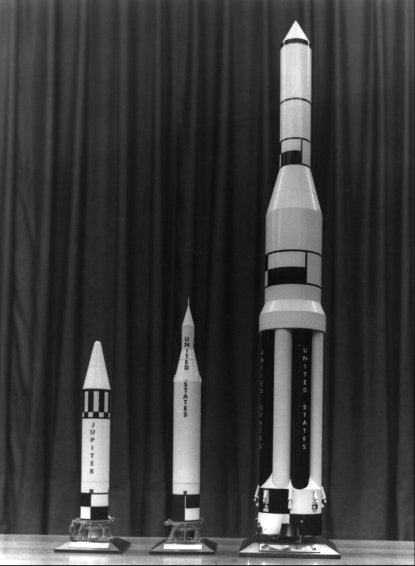
Chapter 3
Launching the First Saturn I Booster
The Magnitude of the Task

Models of Jupiter, Juno, and Saturn I.
Just as launch complex 34 dwarfed its predecessors, Saturn checkout represented a new magnitude in launch operations. The Saturn C-1 stood three times higher, required six times more fuel, and produced ten times more thrust than the Jupiter. Its size, moreover, was only a part of the challenge to the Launch Operations Directorate (LOD) at Cape Canaveral. The costs and complexity had also increased markedly. Because of the costs (eventually $775 million for the Saturn I program's research and development alone), there would be fewer test flights. This meant the engineers at Marshall Space Flight Center (MSFC) had to have more test data per flight - such measurements as the temperature of the flame shield, the pressure in combustion chambers, the rocket's angular velocity in pitch and roll. Whereas two telemetry links (radio transmitter-receiver systems) sending 116 measurements had been adequate for Redstone testing, the first Saturn booster employed eight telemetry links to report 505 measurements. The rocket's overall complexity necessitated a longer checkout: Saturn C-1 launch preparations averaged 9 weeks, almost three times longer than for a Jupiter missile.1
Ultimately the new procedures were to work a major change in the human role on the launch pad. Until the Saturn, the Debus team had been on a first-name basis with the rockets. LOD members who were not crawling around inside the Jupiter worked within a few yards of the pad. The Saturn brought little change initially; checkout for the first Saturn C-1 remained largely a manual operation. In the block house, a console operator with a test manual threw a switch connected to a rocket component and checked the results on a meter or strip chart. Automation on the first Saturn booster was rudimentary, limited to relay logic during the last minutes of countdown. It increased as the Saturn grew more complicated. The addition of a live second stage to the Saturn C-1 and the appearance of the much larger Saturn V dictated greater reliance on machines and computers. By the mid-1960s the Saturn checkout was well on the way to automation. Chapter 16 will address this subject in detail.
NASA had firmed up the Saturn C-1 program in late 1959 by adopting the Silverstein Committee's proposals (pages 13-14). Marshall Space Flight Center would start with the clustered booster (S-1) and dummy upper stages. A second block of missions would add a hydrogen-fueled second stage, and a third block would add a third stage to the stack. The Program Office listed the SA-10 launch, set for April 1964, as the Saturn C-1's debut as an operationally ready vehicle. Plans beyond the ten-vehicle research and development (R&D) schedule were indefinite. A 1960 NASA Long Range Program called for 50 Saturn C-1 and C-2 launches between 1965 and 1970. Twenty of these flights would launch Apollo spacecraft reentry tests, earth orbital missions, and circumlunar shots.2
These plans were altered in January 1961 when Wernher von Braun proposed to eliminate the third stage; a two-stage Saturn C-1 would meet the needs of the early Apollo missions. Following NASA Headquarters formal approval of von Braun's recommendation, the Saturn Office in Huntsville rearranged the ten-vehicle R&D program. Block I, beginning that fall, would consist of four S-1 stage tests from LC-34 (mission numbers SA-1 through SA-4). Block II, the next six launches (SA-5 through SA-10), would add the second stage from the LC-37 launch pad, and from an upgraded LC-34.3
The Saturn C-1 test flights were to prove the design of the launch vehicle. The block I launches in particular would test the eight-engine propulsion system, the clustered tank structure, the first-stage control system's ability to cope with sloshing and nonrigid-body dynamics, and the compatibility of the vehicle and launch facility. During the block I series, Marshall engineers proposed a systematic buildup of tests to prepare the way for two-stage flights. Broadly stated, LOD's responsibilities were fourfold: assuring that transportation had not affected vehicle components, mating stages and ground equipment to verify the compatibility of the different stages, launching the rocket, and analyzing the performance of all vehicle systems immediately after launch to detect flight failures. Although the mission was referred to as "launch vehicle test and checkout," less than half of LOD's scheduled activities involved test performance. The balance of the total launch preparation effort included activities more properly described as assembly, installation, preparation for test, and evaluation of records.4
| Next |